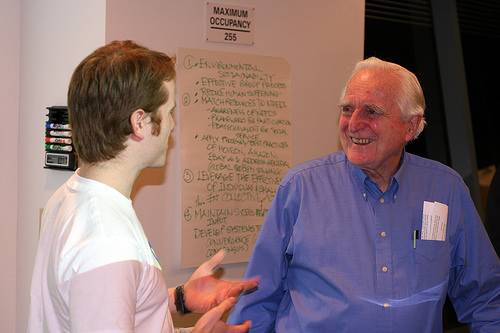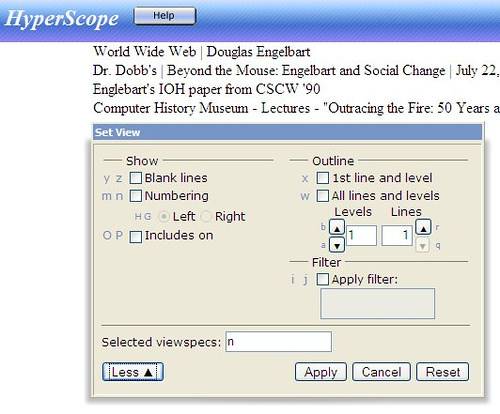Brad Neuberg has announced the release of
HyperScope 1.0, a Web app based on tech legend
Douglas Engelbart’s 1968 NLS/Augment (oNLine System). Engelbart and team have been
working on Hyperscope since March
this year, in a project funded by the National Science Foundation. Its aim is to
rebuild portions of Douglas Engelbart’s NLS system on the web, using current Web
technologies such as AJAX and DHTML.

Brad Neuberg and Doug Engelbart – photo by Niall
Kennedy

The project team members are Doug Engelbart (visionary), Brad Neuberg (software
architect and implementor), Jonathan Cheyer (who knows more about Augment than anyone
else under 35), Christina Engelbart (the bridge between the old and the new) and Eugene
Eric Kim (project liaison and collaboration guru).
Those familiar with their Web history will know that Douglas Engelbart invented the
computer mouse and was a pioneer in the development of hypertext, networked computers and
precursors to GUIs. Indeed NLS was the system demonstrated by Engelbart in his famous
1968 Mother
of All Demos.
What is it?
HyperScope is described as “a high-performance thought processor that enables you to
navigate, view, and link to documents in sophisticated ways.” This is seen as the first
(renewed) step towards Doug Engelbart’s larger vision for an Open Hyperdocument System –
only this time round it’ll be based on Web technologies.

How do you use it?
The goal for HyperScope is to “make
more advanced browsing capabilities available in existing tools, and to engage community
participation.”

I must admit I haven’t fully grokked it yet, but Brad told me to “keep in mind that
this is a faithful reproduction of the earlier systems, with the original commands, so it
takes a bit of training to use.” He also said that one of Douglas Engelbart’s goals is
“to create software that makes experts more powerful”, which means there is a learning
curve. But once you do learn it, you have expanded capabilities. According to Brad, Doug
calls this “software for adults.”
There is a tutorial available and also here are some detailed notes on how to use HyperScope, courtesy of Brad:
“It’s basically a clone of Engelbart’s 1968 system named NLS/Augment; that’s the Turbo
Mode button you will see. It is also a clone of pieces of a later system of Engelbart’s
named VAT, written in SmallTalk, from the early 90’s; those are the Jump and Viewspecs
buttons and overlays you see. That’s the Browser Mode and those little icons you see when
you run the mouse over the rows.
What you see are the original hyperlinks brought onto the web, the ones that were
invented first. They are actually much more powerful than the web’s hyperlinks, allowing
things like indirect linking, granular addressability, the ability to control how a
remote website is displayed using something called viewspecs, transclusions of pieces of
remote web documents in real time, etc. Now they are all brought onto the web, built with
contemporary technology: Ajax, Dojo, DHTML, OPML.”

If you want to have a play, HyperScope 1.0 can be used with both Firefox and Internet
Explorer – but Brad says Firefox is faster and preferred.
How was it built?
HyperScope includes ‘old school’ features like indirect links and transclusions of
remote pieces of other documents. But Brad completely built it with open source
JavaScript toolkit Dojo – meaning that everything
is done on the client-side with Ajax and DHTML. He says it’s a great show-case
application for Dojo. It also uses OPML as its base file format
(Dave Winer will be pleased!). HyperScope is open
source and available under the GPL.
Party like it’s 1968!
To celebrate, the HyperScope team is having a release party this Tuesday at SRI, the
birthplace of Engelbart’s work. Doug will be there, as will many of the original members
of the Augment programming team and the original Xerox PARC team. RSVP here. It’s times like these I wish I was
in Silicon Valley, but if you’re in the neighborhood then it should be a great event.










